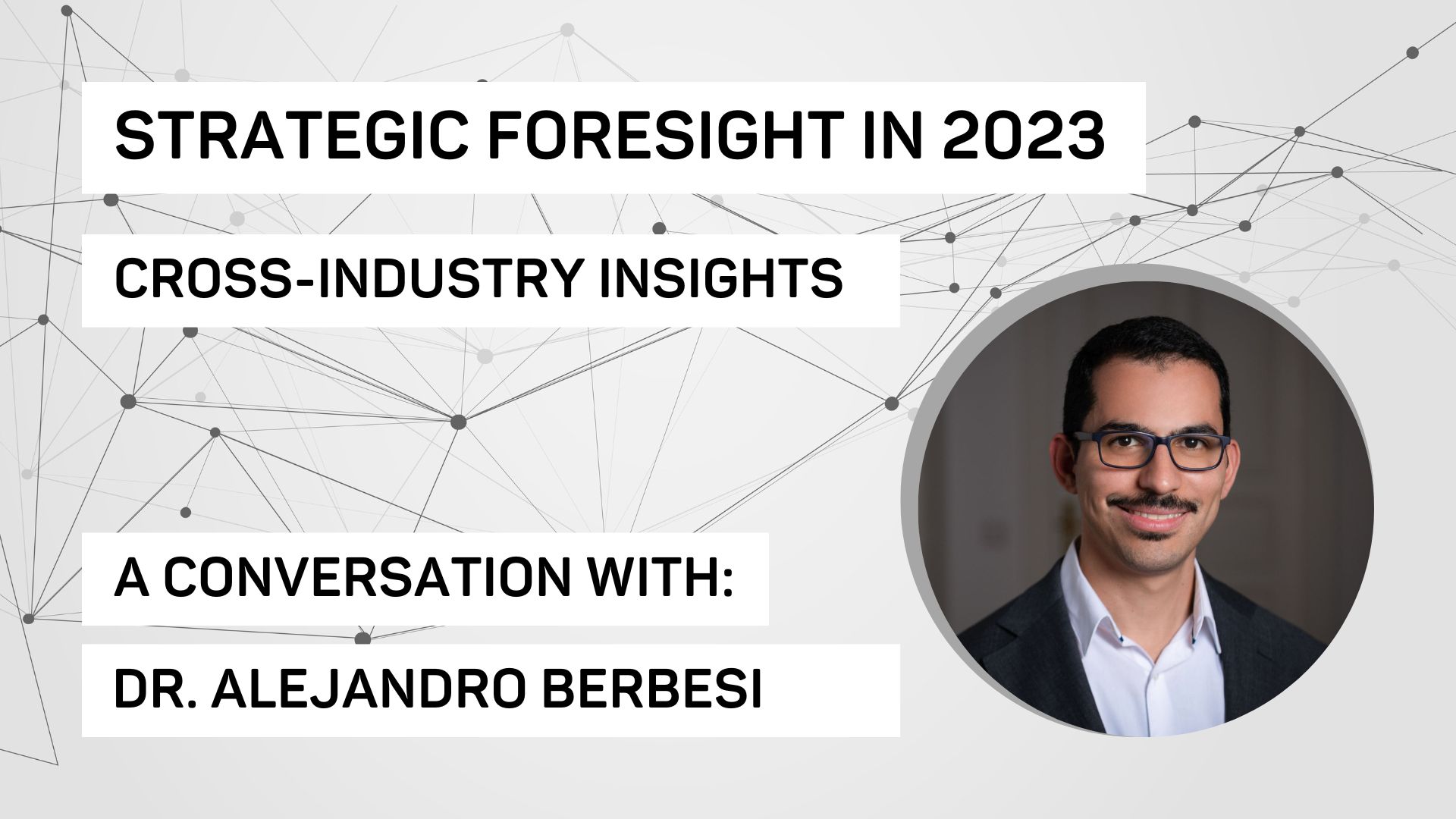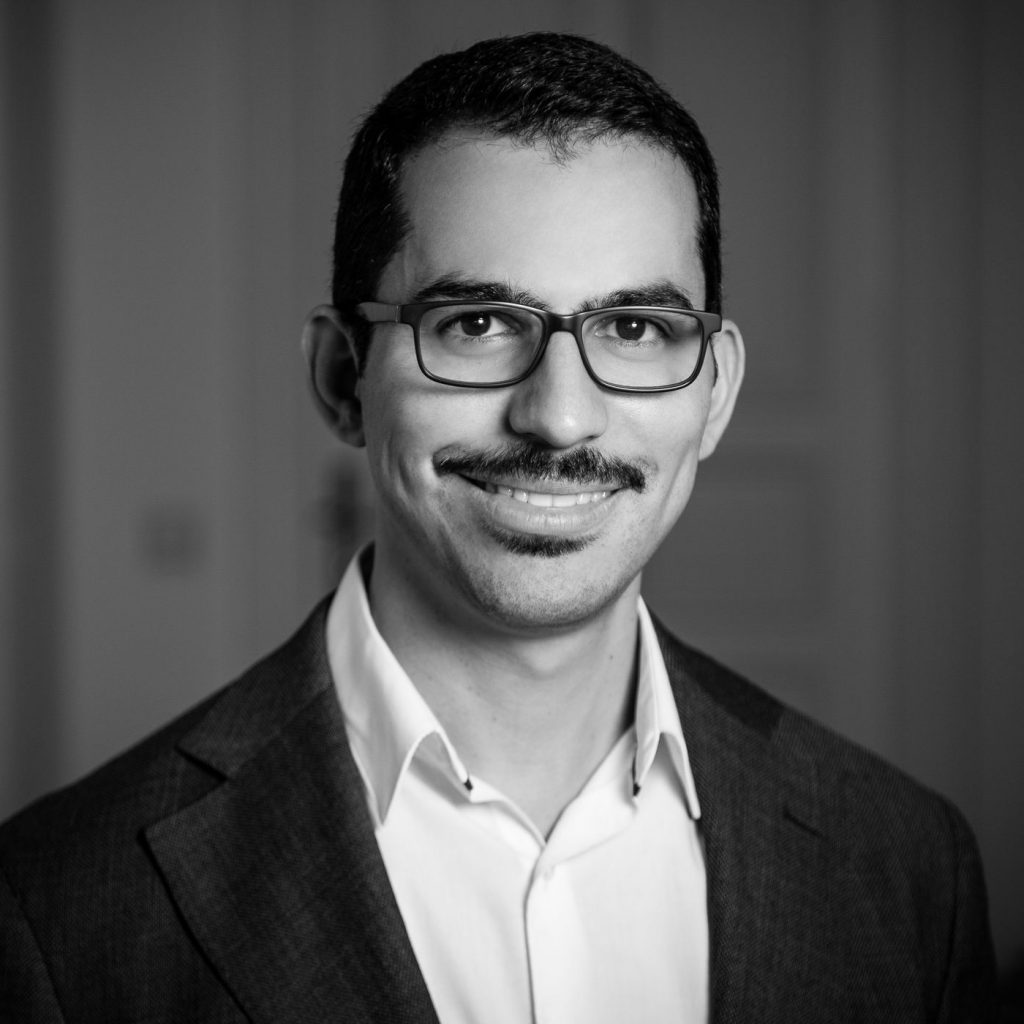
Strategic Foresight in 2023: Cross-industry insights (1/3)
Our strategic foresight expert, Dr. Alejandro Berbesi, on what’s set to impact business this year
By Emily Phillips and Bhavana Sawant
Dr. Alejandro Berbesi is a Manager at Rohrbeck Heger, leading some of the largest and most complex strategy and innovation projects. He also works to develop the team by mentoring colleagues, assessing performance, and tracking development.
In the first of a three-part series we sat down with Alejandro and asked him to reflect on his experiences over the last months. What commonalities did he observe from client work across multiple industries? What advice would he share for strategy and innovation professionals going forward? What topics and trends will move the world in 2023? And what might the future hold for strategic foresight practice?
Skip to part two of our three-part series of interviews with one of our experts in the field of foresight and innovation at Rohrbeck Heger.
Tell us about the projects you’ve worked on this past year.
Alejandro: We have worked with varied industries and clients in the past year, each with unique goals. For two clients we used scenario-based strategizing for the development of future-proof strategies: one client is a division of an international materials technology company with whom we developed their first-ever long term strategy project. The second client is a global food and snack manufacturer seeking to develop their well-being strategy towards 2030. Another interesting project has been the development of a trend and technology radar (and related foresight practices) for an international sportswear manufacturer, including subsequent identification of innovation opportunities based on the radar’s insights.
That’s quite a lot of varied projects and industries! What are some common key insights from the mix of projects you’ve worked on?
Alejandro: Something that has been interesting is this realization that the value chain disruptions that we’ve been experiencing in the last two years are most likely here to stay. How do we go from our world, a world that used to be more globalized and integrated, into one that is more fragmented? And what does it mean for companies: in terms of supply chains, logistics, raw materials? This has become a very important element to consider.
“How do we go from our world, a world that used
– Dr. Alejandro Berbesi
to be more globalized and integrated,
into one that is more fragmented?”
In most of our projects nowadays, the topic of sustainability has become a hygiene factor. Whether it’s the future of chemical manufacturing or sportswear, sustainability is always part of the conversation. And while the topic of sustainability has been there for a while, something that we’re discussing now is the topic of resilience. We all want and hope for a future where society manages to fight climate change, to curb emissions, and where the situation doesn’t escalate significantly. But then the question is: if that fails, what should companies do?
One way to approach this is by working with scenarios. These scenarios are not necessarily the future that we hope for; they are different extreme versions of the future. In the scenario where we don’t manage to fight climate change and we live in a world where resources become more scarce and weather events become more extreme, what does it mean for humanity? For society? What can companies develop on the innovation side?
We experienced this scenario-building process with one of our clients this year, and that was an interesting process to go through.The results are developing solutions that provide more resilience, more adaptation: “how do you colonize Mars, but on Earth?” Again, we don’t hope for this kind of scenario, but it could happen.
Another trend that we see quite a bit, especially with food and snacking and other adjacent categories, is an increasing consumer awareness of well-being and health. Different elements are included in well-being, from physical to psychological. Generally people are becoming more aware of these things. Twenty or thirty years ago, there was this notion that you can either indulge yourself, or you can be healthy. Now, more and more, people want to have both at the same time. They want to enjoy themselves while doing something that is good for their health. For direct to consumer food and snacking businesses, whoever manages to crack the code with the right ingredients, taste, flavor, texture, etc. – they are going to be the winners in this game.
Another key factor driving the future for many, many different industries is increasing levels of regulation. We see how in different B2C and B2B businesses, the impact of regulation is becoming more apparent over time. There are more restrictions when it comes to how to advertise your product, meet sustainability requirements, usage of ingredients and materials, and taxation schemes, etc.
What has your work this past year shown you about the value of strategic foresight methodology?
Alejandro: With scenario-building, we are using fiction and imagination to immerse ourselves in different visions of the future and that’s quite powerful. First, we develop the scenarios together with our clients. The scenarios need to be very different from each other. They need to be extreme, and not necessarily the world that we hope for. Then we formulate different strategic positions or strategy alternatives: e.g. strategies one, two, and three. We take strategy one and test it. We immerse ourselves in these different visions of the world and evaluate how the strategy would perform. And then we do the same for the remaining strategies.
The outcome is actually quite powerful because then — especially if you’re discussing with the management board, where there are different points of view or opinions about what needs to be done — it helps to build a consensus. What decisions will likely work in just one scenario, but then fail in the other three? What decisions would ensure a certain degree of robustness, regardless of how the future turns out?
What advice would you give your clients as they head into 2023?
Alejandro: One piece of advice that I would give to my clients is that there is a tremendous pool of knowledge within their own organization. We have seen it several times. When it comes to knowledge, I think most organizations, especially the large ones, already have what they need to succeed.
It’s all about the communication, how they structure all of this knowledge and information — this is how you learn what is missing. Rohrbeck Heger is super happy to help them with this, because what we do is not only about the content that we deliver, it’s about the whole process that we deliver. It’s what we call a participative approach, which is really about bringing together people with different competencies, from different units, to discuss these topics in a way that they never do.
“We offer clients a participative approach.
– Dr. Alejandro Berbesi
This brings together people with different
competencies, from different units, to discuss
topics in a way that they normally never do.”
Something that I would encourage clients to consider is, rather than trying to buy a lot of new content or knowledge, is to invite others who can come to your organization with a different method to exploit that existing knowledge. Then you will see the things that come out of this, which can be really, really magical, if done in the right way.
How do you see strategic foresight evolving in the coming years?
Alejandro: For a long time before COVID-19 and the war, especially here in Europe, where we had such a period of stability, people were quite comfortable saying how they thought the future was going to be in 10 years or so. They just extrapolated based on what felt intuitive, or “logical.” COVID-19 and the war in Ukraine are two things that none of us hoped for. But if there’s something that we’re learning from those, it is that things we don’t expect at all can suddenly become the reality we live in. So if I asked you, “where are we five years from now, what is the improbable, wildcard event?” – I don’t know.
“I think as society we have become more humble
– Dr. Alejandro Berbesi
in accepting that we don’t know.”
This is why something like foresight becomes so essential, because foresight is not about saying, “this is how the future is going to be.” Foresight is all about embracing the fact that there is a lot of uncertainty. And rather than running away from that uncertainty, it’s about engaging with it, asking the right questions, and examining the alternatives. How can we prepare for those different alternatives?
Whether the industry is sportswear, snacking, or materials technology, strategic foresight helps organizations prepare for an uncertain future by building resilient, robust strategies. The Rohrbeck Heger team is prepared to guide innovation and strategy teams to assess the complexity of many interwoven trends, from increasing regulations, to a focus on health and well-being, to AI and other technological shifts. Reach out to Alejandro to learn more.
To learn more on what’s set to impact business in 2023, head over to part 2 of our three-part interview series where we sit down with Philipp Maron, Senior Foresight Consultant at Rohrbeck Heger.
The interviews have been edited and condensed for clarity.

Your contact at Rohrbeck Heger:
Dr. Alejandro Berbesi
Manager at Rohrbeck Heger
aberbesi@rohrbeckheger.com
LinkedIn
